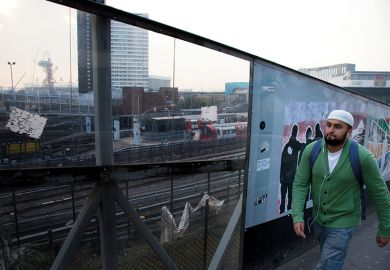There was a spirited ripple of university announcements and strategic tweets this week, as 31 UK universities signed up to an important – and promising – pledge to act as a properly “civic university”. The intriguing #trulycivic hashtag trended for at least 18 minutes, as universities signalled their pride and commitment as “civic promissories”, reaffirming their institutions’ role as “anchor institutions”, “regional skills developers” and “investors in local communities”.
This flurry of senior-quilled commitments signals the publication of an impressive 78-page report from the UPP Foundation Civic University Commission, led by Lord Kerslake: Truly Civic: Strengthening the connection between universities and their places. Over the past year, UK HEIs were invited to feed in submissions on their current and future status as a civic university, answering crystal-ball-shattering questions such as, “How would you measure the success of a civic university on a 100-year timescale?”.
There was a strong temptation to offer visionary scenarios of AI-navigated knowledge excellence framework hoverpods transporting enterprise nuggets to grateful local industries, but many universities submitted rigorous and thoughtful documents, now distilled usefully by the commission’s report.
As part of the Civic University Agreement, signed up to by respective VCs, there are promises to engage in collaborative and co-produced research, effective knowledge transfer, and innovation activities that have a defined impact on the region.
In a welcome transition, the language of the pledge moves quickly from the well-intentioned but earnest claims to “understand local communities”, to harder-edged commitments of “evidence-based” partnerships and measurable impacts on economic and cultural development. A (hopefully benign) metrics of civic engagement is foreshadowed in the promise to be “clear about what we do and how we measure it, so we can say with confidence what we have achieved – and how we might do better in the future”.
There’s a politicised nuance to the agreement, too: a direct challenge to the prevailing habit of measuring the value of higher education in private terms: personal return on tuition fees, individual learning gain and graduate income. Instead the Civic University Agreement approves a public measure of higher education’s impact in supporting “the educational, economic and societal interests of our communities and our places”.
So far, so civic. What is surprising, perhaps, is that within the wording of the agreement, and in the varied recommendations of the UPP report, there’s scant mention of the way that a changed approach to student learning – and more specifically innovative curriculum design – might form the foundation of the civic university. True, there is plenty of welcome space dedicated to the need for educational partnerships, diversity and liaison with FE colleges.
There’s much less, though, on the future shape and remit of university curricula themselves; on how we might design co-curricular opportunities that oblige students to work in a public-facing and public-spirited way. In other words, there is little (apart from references to work-based learning and volunteering) on how we might embed civic learning into the university curriculum.
We need to design programmes, and assessment types, that ensure students work – consistently, reflectively and critically – with local employers, communities, and third sector organisations, producing ideas and outputs that have societal legacy beyond the academy.
Tellingly, all nine uses of the word “curriculum” in the UPP report appear in relation to how universities might transform and support the secondary school curriculum. In this pattern, there’s a whiff of the old model of a university’s civic engagement: “We’re experts, let us show you how to do better”. This is a shame because it goes against the whole spirit and most of the content of the Kerslake report, with its welcome emphasis on reciprocal rather than hierarchical partnerships.
To understand what a civic university might look like we need a sustained analysis of what a truly “civic curriculum” (a phrase absent from the UPP report) might be, and the type of educator that we need to design and support it.
Pleasingly, the sector is awash with excellent examples of such thinking and practice. It’s no coincidence that Lord Kerslake’s adopted city of Sheffield offers good examples. The University of Sheffield’s Engaged Curriculum (led by Brendan Stone) offers one of the most mature and sensitive commitments to civic learning, and both universities in that city seem enmeshed in its life and infrastructure.
At Keele University, we champion regional collaboration under the banner of “The New Keele Deal”, investing in programme design that foregrounds entrepreneurial and cultural collaboration. Our Institute for Innovation & Teaching Excellence, inspired by PVC Helen O’Sullivan’s core commitment to social learning, aims to embed this external-facing, dialogic learning in each faculty, with academic developers, employability consultants and learning technologists forging civic links and conversations. We are realistic, however, about the challenges. It takes a very big shift to blend rigorous conventions of academic study with employer co-design and interaction with civic audiences.
Elsewhere, the civic commitment of universities is increasingly well-defined. The University of Lincoln has recently re-articulated its identity as “A new civic university”, and Staffordshire University defines its new strategic mission rigorously and inclusively as a “connected university”. In the capital, UCL and LSE compete to realise the ambitions of Dilly Fung’s influential Connected Curriculum scholarship, and, in 2017, the University of Leeds dedicated a two-day conference to “Exploring the civic curriculum”.
No shortage of strategic inspiration and civic pedagogy, then, so let’s not miss this opportunity. To earn the hashtag #trulycivic and return on their pledge, universities can certainly pay attention to enterprise, to co-produced and impactful research, and also to glass-fronted innovation incubators. But let’s not forget the collective power of students as agents of civic engagement, and let’s be sure, as part of our promise, to design curricula that help them on their way.
Rafe Hallett is director of the Keele Institute for Innovation and Teaching Excellence and associate professor of history at Keele University.
Register to continue
Why register?
- Registration is free and only takes a moment
- Once registered, you can read 3 articles a month
- Sign up for our newsletter
Subscribe
Or subscribe for unlimited access to:
- Unlimited access to news, views, insights & reviews
- Digital editions
- Digital access to THE’s university and college rankings analysis
Already registered or a current subscriber?




